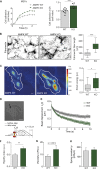AMPK negatively regulates tensin-dependent integrin activity
- PMID: 28289092
- PMCID: PMC5379951
- DOI: 10.1083/jcb.201609066
AMPK negatively regulates tensin-dependent integrin activity
Abstract
Tight regulation of integrin activity is paramount for dynamic cellular functions such as cell matrix adhesion and mechanotransduction. Integrin activation is achieved through intracellular interactions at the integrin cytoplasmic tails and through integrin-ligand binding. In this study, we identify the metabolic sensor AMP-activated protein kinase (AMPK) as a β1-integrin inhibitor in fibroblasts. Loss of AMPK promotes β1-integrin activity, the formation of centrally located active β1-integrin- and tensin-rich mature fibrillar adhesions, and cell spreading. Moreover, in the absence of AMPK, cells generate more mechanical stress and increase fibronectin fibrillogenesis. Mechanistically, we show that AMPK negatively regulates the expression of the integrin-binding proteins tensin1 and tensin3. Transient expression of tensins increases β1-integrin activity, whereas tensin silencing reduces integrin activity in fibroblasts lacking AMPK. Accordingly, tensin silencing in AMPK-depleted fibroblasts impedes enhanced cell spreading, traction stress, and fibronectin fiber formation. Collectively, we show that the loss of AMPK up-regulates tensins, which bind β1-integrins, supporting their activity and promoting fibrillar adhesion formation and integrin-dependent processes.
© 2017 Georgiadou et al.
Figures






Similar articles
-
Tensins: Bridging AMP-Activated Protein Kinase with Integrin Activation.Trends Cell Biol. 2017 Oct;27(10):703-711. doi: 10.1016/j.tcb.2017.06.004. Epub 2017 Jul 8. Trends Cell Biol. 2017. PMID: 28698049 Review.
-
N-cadherin cell-cell adhesion complexes are regulated by fibronectin matrix assembly.J Biol Chem. 2011 Jan 28;286(4):3149-60. doi: 10.1074/jbc.M110.115733. Epub 2010 Nov 17. J Biol Chem. 2011. PMID: 21084302 Free PMC article.
-
Integrin dynamics and matrix assembly: tensin-dependent translocation of alpha(5)beta(1) integrins promotes early fibronectin fibrillogenesis.J Cell Biol. 2000 Mar 6;148(5):1075-90. doi: 10.1083/jcb.148.5.1075. J Cell Biol. 2000. PMID: 10704455 Free PMC article.
-
The fibronectin-binding integrins alpha5beta1 and alphavbeta3 differentially modulate RhoA-GTP loading, organization of cell matrix adhesions, and fibronectin fibrillogenesis.J Cell Biol. 2002 Dec 23;159(6):1071-86. doi: 10.1083/jcb.200205014. Epub 2002 Dec 16. J Cell Biol. 2002. PMID: 12486108 Free PMC article.
-
Integrating actin dynamics, mechanotransduction and integrin activation: the multiple functions of actin binding proteins in focal adhesions.Eur J Cell Biol. 2013 Oct-Nov;92(10-11):339-48. doi: 10.1016/j.ejcb.2013.10.009. Epub 2013 Nov 4. Eur J Cell Biol. 2013. PMID: 24252517 Review.
Cited by
-
Engineering metabolism to modulate immunity.Adv Drug Deliv Rev. 2024 Jan;204:115122. doi: 10.1016/j.addr.2023.115122. Epub 2023 Nov 5. Adv Drug Deliv Rev. 2024. PMID: 37935318 Free PMC article. Review.
-
Integrin trafficking in cells and tissues.Nat Cell Biol. 2019 Feb;21(2):122-132. doi: 10.1038/s41556-018-0223-z. Epub 2019 Jan 2. Nat Cell Biol. 2019. PMID: 30602723 Free PMC article. Review.
-
PTEN inhibits AMPK to control collective migration.Nat Commun. 2022 Aug 11;13(1):4528. doi: 10.1038/s41467-022-31842-y. Nat Commun. 2022. PMID: 35953476 Free PMC article.
-
Hic-5 regulates fibrillar adhesion formation to control tumor extracellular matrix remodeling through interaction with tensin1.Oncogene. 2018 Mar;37(13):1699-1713. doi: 10.1038/s41388-017-0074-2. Epub 2018 Jan 19. Oncogene. 2018. PMID: 29348458 Free PMC article.
-
Angiopoietin-2 blockade ameliorates autoimmune neuroinflammation by inhibiting leukocyte recruitment into the CNS.J Clin Invest. 2020 Apr 1;130(4):1977-1990. doi: 10.1172/JCI130308. J Clin Invest. 2020. PMID: 32149735 Free PMC article.
References
-
- Banko M.R., Allen J.J., Schaffer B.E., Wilker E.W., Tsou P., White J.L., Villén J., Wang B., Kim S.R., Sakamoto K., et al. . 2011. Chemical genetic screen for AMPKα2 substrates uncovers a network of proteins involved in mitosis. Mol. Cell. 44:878–892. 10.1016/j.molcel.2011.11.005 - DOI - PMC - PubMed
Publication types
MeSH terms
Substances
Associated data
- Actions
Grants and funding
LinkOut - more resources
Full Text Sources
Other Literature Sources

